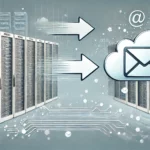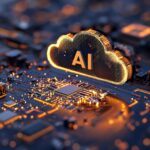Seamless migration: Moving on-prem mailboxes to the cloud

Since 2020, most businesses have shifted their Microsoft Exchange mailboxes to the cloud. As of 2023, just 16 percent of Microsoft Exchange mailboxes operated on-premises -- a clear indication that organizations are seeking the improved scalability, reliability, and cost efficiency of cloud-based solutions.
However, migrations from on-prem mailboxes can be challenging. They can disrupt business operations, present security risks, and create compliance challenges. Without proper migration planning, businesses face significant vulnerabilities and risks. On top of this, support continues to diminish for various platforms. Just recently, Microsoft announced its sunsetting support for Exchange 2016 and 2019 later this year.
Rethinking risk -- are you taking the right path around security?

In the film Sliding Doors, a split second choice leads to two branching stories -- yet while the two stories are very different, they both lead to hospital trips and potential tragedy. The world of cyber security is similar. Whatever decisions we make, we are still under pressure and we will -- eventually, whatever we do -- end up facing significant risk.
Yet how do we show that we are doing a good job? If everything is working, there is nothing to see. Or have we collectively just been lucky to that point? Unless you have an active attack taking place, you can argue that your efforts are enough. But when you only look at a single point in time, it is a challenge to show that you are making a difference and reducing risk.
Top 10 data security best practices for 2025

2024 ushered in one of the biggest shifts in data security, as cyber threats continued to increase in sophistication by leveraging advancements in AI to outpace traditional defenses. High-profile breaches across all industries continued, uncovering vulnerabilities in even the most robust systems. Meanwhile, the ongoing hybrid work models and migration to cloud-based technologies expanded the attack surface, creating new challenges for protecting sensitive data.
As 2025 rolls on, organizations need to follow best practices that represent a proactive, forward-thinking framework to stay ahead of emerging threats, protect critical data, and maintain the trust of their stakeholders. Here are ten best practices that organizations should consider.
How startups are redefining conflict

Conflict, like everything else these days, is now shaped by technology. The old model -- industrial-scale production, multi-decade procurement cycles, and the primacy of sheer manpower -- is fading. In its place something faster, leaner and more precise is emerging. Small teams with energy, ambition and good ideas now do in months what legacy contractors once did in years. In Ukraine, for example, drones built by startups and programmed by engineers barely out of university, are destroying tanks worth millions of dollars. The battlefield is changing. And with it, so is the balance of power.
A modern conflict, then, is not won by the biggest army. It’s won by those who can see first, move first, and strike first. This is the reality that some countries in some regions have been slow to grasp. I am a German citizen with friends in the force who have witnessed this first-hand. Their systems are bureaucratic, their procurement cycles sluggish. In a world where technology evolves in real time, they cannot keep pace. And after decades of peace, they haven’t felt motivated to do so.
The biggest security flaw of every cloud service that no one talks about -- until it's too late

Do you trust your SaaS vendor with the keys to your kingdom? The agent running on your systems is only as secure as your cloud vendor’s security posture. It’s a security risk that should keep every organization’s IT and security teams up at night.
Many vendors will cite pen testing, bug bounty programs, and certifications like SOC 2 and ISO 27001 as a testament to their security. But the reality is that breaches still happen.
The cost conundrum of cloud computing

For most businesses, change is driven by the need to reduce risk and innovate, while optimizing cost and return on investment. In the case of cloud adoption, the powerful functionality offered by these platforms enable businesses to streamline, optimise, and make their workflows more efficient which, in turn, helps reduce costs. Organizations are always looking for the best solutions for optimizing efficiency and reducing costs, particularly in uncertain economic times.
Yet, in reality, migrating to the cloud does not always bring the cost optimization and savings that an organization is looking to benefit from. Depending on which cloud solution is being evaluated, along with how the solution is designed, built, and deployed, the result may not deliver on the project’s original goals.
Seamless cloud migration: Building an AI-optimized future

Implementing cloud services with AI technologies, such as Microsoft Copilot, is fundamental for IT providers seeking to offer advanced solutions. However, with greater dependence on AI-generated tools to foster innovation and productivity in organizations, the necessity of enabling cloud environments to host these sophisticated capabilities has become paramount.
Their successful integration, however, comes at the expense of having additional investments in computing power, data analytics, and intelligent security solutions that shield sensitive information from unauthorized access. Many companies first need to accomplish a cloud migration to improve the security posture of the infrastructure before implementing AI.
Need to search terabytes of enterprise data? Tips for getting quickly to that 4-leaf clover

If you find yourself in a springtime clover field hunting for that rare 4-leaf clover, the journey is the reward. Not so if you and your team are hunched over your desks hunting 4-leaf clovers in terabytes of enterprise data. While combing through millions of files is never a “walk in the park,” enterprise search makes this process exponentially more pleasant.
To enable instant concurrent searching across terabytes, enterprise search first has to index the data. Indexing is simple: just tell the indexer the folders, emails archives and the like to index, and the software will take it from there. (This article uses dtSearch for its specifics on enterprise search but there are other comparable products on the market.) Tip: the files to index can be local or remote like SharePoint attachments, OneDrive / Office 365 files, etc. that appear as part of the Windows folder system.
Working with AI: When should humans be 'in the loop' or 'over the loop'?

It’s a fact that over 80 percent of AI projects fail. Not because of AI’s potential, but because businesses prioritize minor use cases over real transformation. Automated insights and meeting summaries may be impressive, but AI only drives impact when seamlessly integrated into workflows, turning insights into action.
Deploying AI successfully isn’t simple, and organizations are complex. Effective AI deployment requires a clear framework for human oversight. AI should usually enhance human decision-making, providing targeted, explainable, and interactive insights. But in some cases -- especially when decisions are time-sensitive or involve vast amounts of data -- humans cannot oversee every output in real time. This raises a key question: when should humans be ‘in the loop,’ actively making decisions, and when should they be ‘over the loop,’ overseeing AI without direct intervention? Getting this balance right is crucial for both AI’s effectiveness and its responsible use.
Fax in 2025: How cloudification is revolutionizing financial services

Digital transformation is causing the financial services industry major problems when it comes to how highly sensitive, time-critical information in transmitted. Adding to these challenges are the radical changes in customer expectations in recent years, as digital communications have taken hold in nearly every aspect of consumers’ lives.
To remain viable, outdated communication structures -- particularly those relying on servers and distributed systems -- need to be consolidated and standardized. Few industries are more prepared for this transformation than financial services, where significant investments are already being made to improve operational efficiencies and competitiveness. As some of the world’s largest financial institutions invest in modern technologies like cloud migration and AI, attention is turning to some of their oldest tools that are still in use. Fax is a prime example.
Beyond DeepSeek: 3 critical questions for the future of AI

This year started with a shockwave for the tech world, and the AI community in particular. Launched by a relatively obscure Chinese startup, DeepSeek not only challenged the rules of the AI game by sending Nvidia's stock plummeting 17 percent in one day and becoming the most-downloaded app on the App Store and Play Store, but also showed the persisting security problems by accidentally exposing its database and leaking sensitive data including chat histories, API keys and backend operational details.
Success and failures aside, DeepSeek made the world realize how quickly and deeply a single AI model release can impact global events, and this raises three questions. First, how legitimate (and sustainable) are the massive AI investments in the West? Second, what risks and opportunities does open-source development pose? Finally, is it possible to balance growth and innovation with data privacy and security amidst a global AI race?
Inside a cyberattack: How hackers steal data

The truth about cybersecurity is that it’s almost impossible to keep hackers outside of an organization, particularly as the cybercrime industry becomes increasingly sophisticated and their technology more advanced.
Once a hacker has broken through an organization’s defenses, it is relatively easy to move within the network and access information without being detected for days, and even months. This is a significant concern for Banking and Financial Services organizations, which house valuable sensitive and Personally Identifiable Information (PII). The goal of cybersecurity is to minimize the risk and the impact of a breach. Understanding the adversary’s mindset and activity is central to this.
Why API-first engineering is the way forward for software development

British software developer and international public speaker on software development, Martin Fowler once famously said: “Any fool can write code that a computer can understand. Good programmers write code that humans can understand.” His book on Refactoring has been a best seller for decades and is a guide on how to transform code safely and rapidly, helping developers build better code. Exactly these same principles should apply when looking to develop an API-first approach to software engineering.
But first, what do we mean when we talk about an API-first approach? This is a software development method that prioritizes the design of APIs before writing any other code, instead of treating them as an afterthought. This is different from the traditional approach, where the application code is written first, and the API is added later.
Five ways data platforms are underpinning the second cloud revolution

According to Gartner, over the next few years hybrid cloud will become the de facto approach for unlocking value from data. The projections are stark. Nine-in-ten organizations will adopt a hybrid cloud model by 2027, and end user spending globally on public cloud will grow by 21.4 percent this year alone, reaching more than $723 billion. Application services, system infrastructure services and Platform-as-a-Service (PaaS) will all see a boost in spending as well. By anyone’s money, these are huge numbers.
This second cloud revolution is being driven by data. When combined with analytics, data is a uniquely valuable asset for any business. If harnessed correctly, it can grow revenue, reduce costs, and entirely transform a business by opening up fresh market opportunities through the use of new technologies like GenAI.
From fixing issues to fueling innovation: The growing business case for observability

This year, embracing a leading observability practice will not only be a key priority for organizations but an essential competitive differentiator. Recent data shows that leading organizations with mature observability practices spend 38 percent more of their time on innovation, in contrast with organizations early on in their observability journey. This greater amount of time to focus on product innovation can equate to significant benefits for an organization, such as increased developer productivity, improved operational efficiency and more importantly winning market share.
2024 has shown us that the impact and business value of observability is expanding. It is evolving from a reactive practice to a proactive one where organizations not only use observability for troubleshooting issues but now also to inform their customer experience strategy and to fuel faster innovation.
© 1998-2025 BetaNews, Inc. All Rights Reserved. About Us - Privacy Policy - Cookie Policy - Sitemap.
